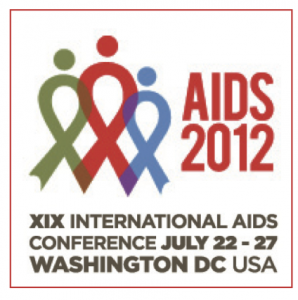Elvitegravir vs raltegravir: 96 week phase III results in treatment experienced patients
1 August 2012. Related: Conference reports, Antiretrovirals, World AIDS 19 Washington 2012.
 Simon Collins, HIV i-Base
Simon Collins, HIV i-Base
Richard Elion from Whitman-Walker Health in Washington presented updated 96 week results from the phase 3 head-to-head study of elvitegravir vs raltegravir. [1]
The 48 week results, first presented at the IAS conference in Rome last year showed elvitegravir to be non-inferior to raltegravir based on viral suppression to <50 copies/mL. [2]
This phase 3 study randomised 712 treatment-experienced patients to either the investigational integrase inhibitor elvitegravir (150 mg once-daily) or raltegravir (400 mg twice-daily), each with matching placebo, plus a background regimen of a boosted protease inhibitor (PI) plus a third drug.
Baseline characteristics included mean age 45 years; 18% women; mean CD4 count 260 cells/mm3 (45% with CD4 <200), median viral load 20,000 copies/mL (with 26% >100,000 copies/mL) and 5% and 15% of patients were coinfected with HBV or HCV respectively. Approximately 63% patients had primary resistance to drugs in two or more classes (PI 33%, NRTI 72%, and NNRTI 61%), balanced between arms. Choice of background PI was largely darunavir (58%), lopinavir/r (19%) or atazanavir (16%). The third drug was an NRTI in 80% of patients (tenofovir 59%, tenofovir/FTC 27%, abacavir 4%, 3TC 3%, other 7%) with 13% using etravirine and 6% using maraviroc.
The primary endpoint of viral load <50 copies/mL through week 48 (time to loss of virologic response [TLOVR] analysis) was achieved by 59% of elvitegravir vs 58% raltegravir patients respectively.
Virological response out to 96 weeks dropped similarly in each arm (to 48% vs 45%%), maintaining non-inferiority for the comparison (difference 2.6; 95%CI –4.6, +9.9). Approximately 40% of patients in each arm discontinued before week 96. Reasons were balanced between arms (non-compliance: 39 vs 34; loss to follow-up: 29 vs 31, lack of efficacy: 17 vs 21, etc) expect for withdrawal of consent (30 vs 17), all elvitegravir vs raltegravir, respectively. The respective percentages of patients with virological failure increased to 26% vs 29% and 26% of patient in each arm had discontinued for other reasons (including side effects). CD4 increases were similar at +205 vs + 195 cells/mm3 (all elvitegravir vs raltegravir, respectively).
Genotypic resistance test results were available for approximately 25% of patients with virological failure in each arm, with a quarter of these in each arm (23/87 vs 26/93) having integrase inhibitor-associated mutations. Although some mutations were shared, elvitegravir was associated with T66I/A (n=8), E92Q/G (n=7), N155H (n=5), T97A (n=4), S147G (n=4) and Q148R (n=4); and raltegravir with N155H (n=16), Q148H (n=7) and T97A (n=4). Resistant mutations associated with NRTIs (3%), PIs (1%) and NNRTIs (2-3%) were similar in each arm. A more detailed analysis of the resistance results was presented as a separate poster. [3]
Grade 2-4 side effects were similar (68% in each arm) with slightly higher diarrhoea with elvitegravir (13% vs 7%). Limited details were provided for the 20% rate of serious side effects in each group but these only led to discontinuation in 4% vs 3% of patients. Grade 3/4 laboratory abnormalities were also similar, except for slightly higher ALT/AST/GGT in the raltegravir arm (2-3% vs 5-7%).
Elvitegravir has already been submitted to both the to the FDA and EMA for a decision on regulatory approval as a single agent.
References:
- Elion R et al. Efficacy and safety results from a randomized, double blind, active controlled trial of elvitegravir (once-daily) versus raltegravir (twice-daily) in treatment-experienced HIV-positive patients: long term 96-week data. 19th International AIDS Conference. 22-27 July 2012, Washington. Oral abstract TUAB0105.
http://pag.aids2012.org/Abstracts.aspx?SID=202&AID=5823
http://pag.aids2012.org/flash.aspx?pid=1386 - Molina J-F et al. Elvitegravir once-daily is non inferior to raltegravir twice-daily in treatment experienced patients: 48 week results from a phase 3 multicenter, randomized, double blind study. 6th International IAS Conference on HIV Pathogenesis, Treatment and Prevention. 17-20 July 2011, Rome. Oral late breaker abstract WELBB05.
http://pag.ias2011.org/Abstracts.aspx?SID=44&AID=4757 - Margot NA et al. Low rates of integrase resistance for elvitegravir and raltegravir through week 96 in the phase 3 clinical study GS-US-183-0145N. 19th International AIDS Conference. 22-27 July 2012, Washington. Poster abstract TUPE050.
http://pag.aids2012.org/abstracts.aspx?aid=19167

